Contemporary Works
Dialogue with Material
My work stems from a sustained contemplation of the inherent distinctions between ceramic and non-ceramic materials, as well as the subtle relationship that unfolds between these materials and me as their maker. Every material bears its own intrinsic character―wholly independent from mine. To acknowledge this separateness is to enter a field of creative tension, where two differing entities seek a point of contact. Such contact can occur only within the fragile dimensions of time and space, where our encounter takes shape and creativity is allowed to emerge. This encounter is the very core of my practice.
As an artist, I strive not to impose my identity upon the materials. I must remain within the bounds of receptive empathy and coexistence. Nor do I expect the materials to “recognize” me in return. If this essential distance is neglected, the work loses its vitality. Preconceptions, when projected too strongly, obscure the individuality of the materials and sever the possibility of a genuine exchange. Failing to acknowledge their otherness ultimately renders true dialogue―and thus true creativity―impossible.
In ceramic art, it is crucial to acknowledge that materials exist as autonomous entities. At the same time, they invite me to recognize my own distinctiveness. Broadly speaking, creativity arises from the interplay between these two independent presences, each revealing its uniqueness to the other. To sustain this reciprocity, the relationship must remain fluid rather than fixed. Rapidly imposing predetermined ideas constrains the encounter, defining it too narrowly and avoiding the necessary risk of distance, much like resisting the diversity and shifting rhythms of contemporary society. In this sense, the act of creation inevitably carries social and political dimensions, for it reflects how we negotiate otherness in the world around us.
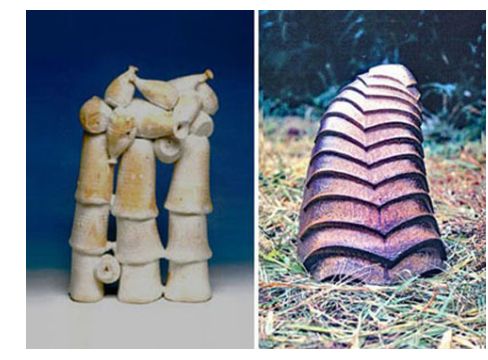
Right: "Great Britain," h -60.0 cm, stoneware with slip, fired in a gas kiln to 1270 degrees C.. Piece made at Manchester Metropolitan University. Exhibited at "Makoto Hatori" Leigh Gallery, London, 15-27 June, 1993. Collection of Stoke-on-Trent City Museum (U.K.) Right: "Guidepost of Bamboo Sprout," (w)34.0 -(d)31.0 -(h)41.0 cm, wood-fired stoneware with natural wood ash, Bizen traditional way fired to 1300 degrees C., eight-day firing. 48th Faenza International Ceramic Art Competition. Exhibited at International Museum of Ceramics, Faenza, Italy, September 18- October 24, 1993.
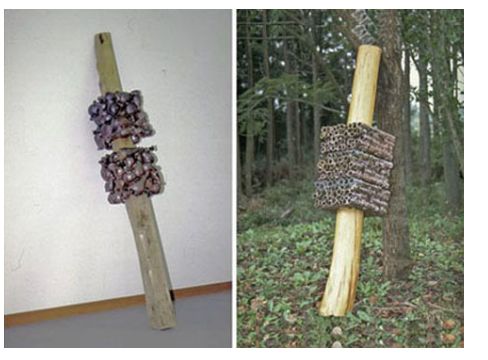
Left: "Cluster,"(w)23.0-(d)23.0-(h)150.0 cm, wood-fired stoneware with natural wood ash, with wood, traditional way fired to 1280 degrees C., eight-day firing, Fletcher Challenge Ceramics Award 1996. Exhibited at Auckland Museum, New Zealand, August 8- September 8, 1996. Right: "Parasitism," (w)27.0 -(d)27.0 -(h)150.0 cm, stoneware and slip painting, with wood (log), wheel thrown and assembled ceramic forms, natural glaze, traditional way fired to 1300 degrees C. in oxidized atmosphere, eight-day firing. Contemporary Art Works of Faith'97, the Fifteen Biennale Exhibition, the Liturgical Art Guild. Exhibited at the Schumacher Gallery Capital University, Columbus, Ohio, U.S.A., March 16- April 13, 1997.
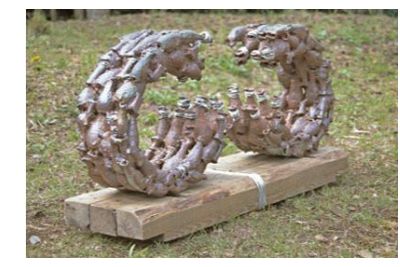
Right: "Confrontation," (w)97.0 -(d)25.0 -(h)51.0 cm, heel-thrown stoneware with slip, wire, and wood addition, traditional way fired to 1300 degrees C. in oxidized atmosphere, ten-day firing. Published in The Ceramic Design Book, A Gallery of Contemporary Work, p.163, Lark Books, 67 Broadway Asheville, NC 28801, U.S.A., 1998.
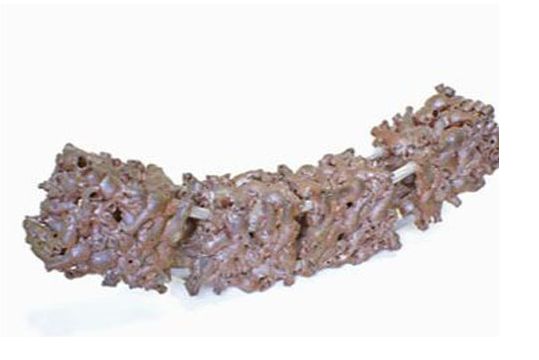
Left: "Composition," (w)106.0 -(d)19.0 -(h)36.0 cm, stoneware with slip, sprayed solution of salt, wire additions, traditional way fired to 1280 degrees C., oxidation, eight-day firing, the Sixth TaiwanGolden Ceramics Awards, Exhibited at Taipei County Yingko Ceramic Museum, Taiwan, October 28, 2000- January 28, 2000.

Right: "On Instinct," (w)48.0 -(d)42.0 -(h)30.0 cm, stoneware with slip, sprayed surface with the solution of salt and wire additions, wood-fired, traditional way fired to 1200 degrees C., eight-day firing, Sidney Myer Fund International Ceramics Award 2002. Exhibited at Shepparton Art Gallery, Victoria, Australia, February 27- April 25, 2002.

Left: "Ballooning Body," (w)36.0 -(d)33.0 -(h)55.0 cm, stoneware with slip, sprayed solution of salt and metal stand, traditional way fired to 1280 degrees C. oxidation, eight-day firing, 6th International Biennial of Ceramics Manises. Exhibited at Manises Ceramic Museum, November 14, 2003- January 18, 2004.
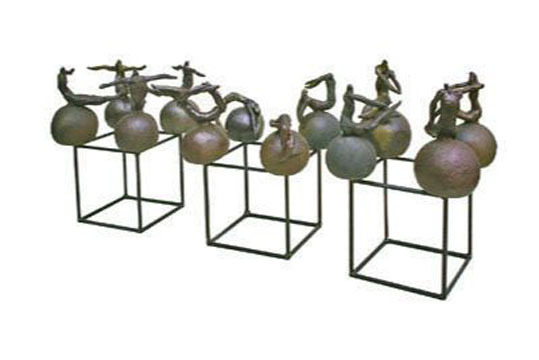
Right: "Argue for Argument's Sake," (w)40.0 -(d)120.0 -(h)44.0cm, hand-build stoneware, natural wood ash, traditional way fired to 1250-1300 degrees, eight-day firing, on metal stand, Sidney Myer Fund International Ceramics Award 2008. Exhibited at Shepparton Art Gallery, Victoria, Australia, March 7- April 27, 2008.
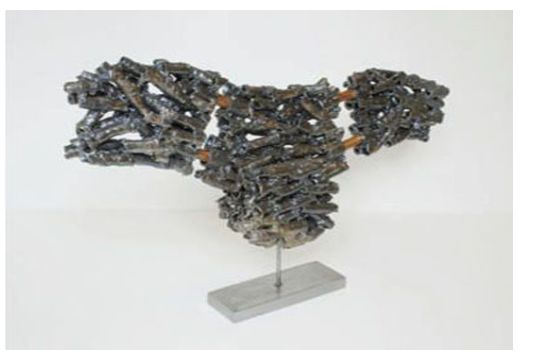
Left: "High Into the Air," (w)92.0 -(d)15.0 -(h)50.0cm, wheel-thrown stoneware with slip, wood fired and charcoal smoked, fired to 1250 degrees C. in reduction, eight-day firing, with twig and metal, 2013 Cluj International Ceramics Biennial. Exhibited at Cluj-Napoca Museum of Art, Romania, October 9- November 3, 2013.
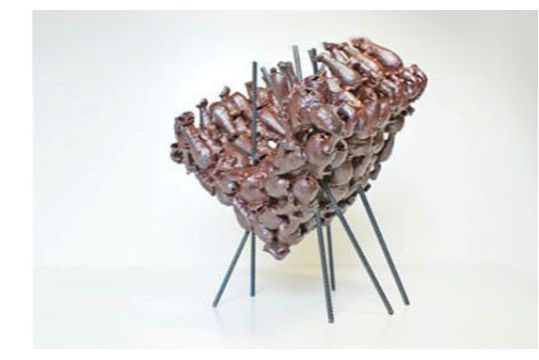
Right: "Inductive Inference," (w) 49.0-(d)34.0 -(h)52.0cm, wheel-thrown stoneware and slip, wood fired and charcoal smoked, fired 1280 degrees C. in oxidized atmosphere, eight-day firing, with iron rod, Seres'14, 3rd International Exhibition of Ceramics and Glass. Exhibited at Anadolu University, Yunusemre Campus, Congress Centre, Eskisehir, Turkey, 15- 17 October, 2014.
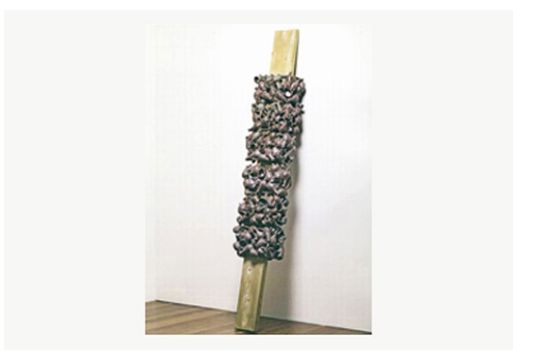
Left: "Parasitism," (w)34.0 -(d)19.0 -(h)205.0 cm, wheel-thrown and stoneware with slip, wood fired and charcoal smoked, 1280 degrees C. in reduction, wood and epoxy. Gyeonggi International Ceramic Biennial 2015, Rep. of Korea. Exhibited at Icheon World Ceramic Center 167-29, Gyeongchung-daero 2697 Beon-gil, Icheon-si, Gyeonggi-do, 467-020, Rep. of Korea, April 24-May 31, 2015.
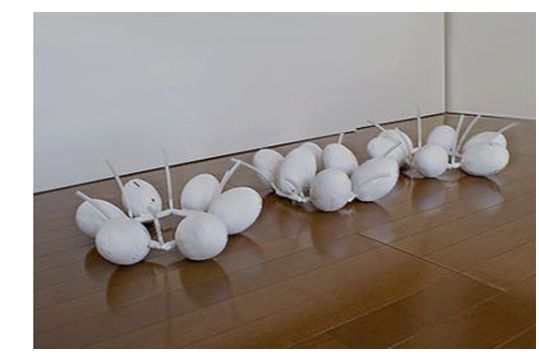
Right: "Non-color; Otherness (05-28-1)," (w)125.0–(d)45.0–(h)16.0 cm, hand-built stoneware elements assembled over some threaded iron rod, non glaze with slip, silicon tube, iron rod and epoxy, electric kiln, fired 1250 degrees C. in reduction. Consists of 3 pieces, mixed-media, the 5th International Triennial of Silicate Arts, Organized by the Foundation for Contemporary Ceramic Arts, Hungary. Exhibited at the Kecskemét Cultural and Conference Centre, Hungary, September 3- September 30, 2017.
In a “White” that Germinates
The concept of "unglazed" ceramics is to eliminate superficial decoration and explore the essence of "objects" as materials. It deviates from the conventional rhythm of pottery, departing from the notion of completion after firing, embracing the inherent qualities of the 'object', and reflecting the complexity of human emotions. The absence of color, termed as 'non-color', deeply resonates with Japan's traditional unglazed pottery (natural glaze), aligning with a sensibility rooted in the aesthetic of 'wabi' and 'sabi', akin to a naturalistic perception.
White, or rather 'non-color', serves as a canvas for introspection. It rejects facile categorizations, prompting us to explore purity and potentiality. By lacking color, an intertwining of impurities and potentialities emerges, further expanding the breadth of interpretation with the inclusion of disparate materials (non-ceramic materials). Thus, enigmatic spaces are born. The egg form is, quite literally, a symbol transcending shape. It embodies 'androgynous form', suggesting the infinite. Within its simplicity lies a profound message about the pursuit of existence and ideals.
Like life, the artwork possesses a duality of transience and resilience, beginnings and infinite possibilities. In the 'blank spaces' such as absence and presence, altered movements, we discover their beauty and significance. Unglazed pottery and its egg form are a vivid, unadorned, enigmatic 'dance' that reflects the human experience.


